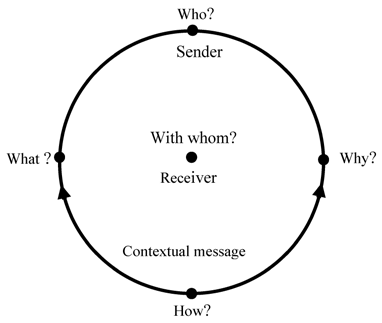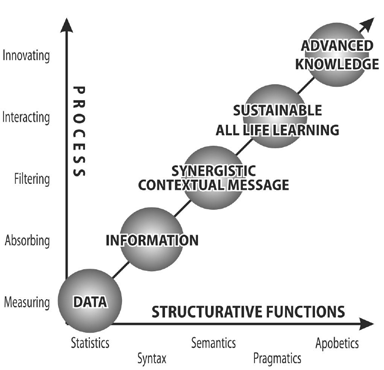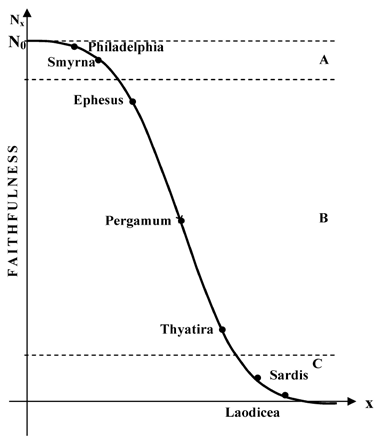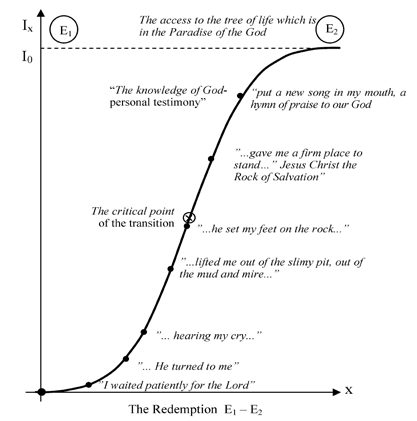Abstract
The two very complex symbols, Bethel and Ai, are associated with two very specific axiological communicational sources for the people living on the earth, with information and knowledge transmitted in every possible direction, having a different impact on the listeners. BETHEL is considered to be the place where negentropic actions are happening, where Wisdom and goodness are speaking to all the smart people interested in the message. AI is the source of the entropic events, where complete chaos and madness spread outward to all the people of the city, where foolishness and evil have a permanent voice. The transitional processes are well-defined processes, aimed to create new emergent states, evil or goodness; also, using the Kuramoto weak coupled oscillators model as a basis in order to explain the entropic and negentropic transitions in different semiophysical contexts by introducing the interaction parameter fp of faithfulness within the environment, represented in this context by the Pantokrator. The use of the transdisciplinary knowledge search window as a new methodology works with the top-down and bottom-up levels of knowledge, integrating complementarily the advanced knowledge through DIMLAK (Data, Information, Messages, Learning, and Advanced Knowledge) model. The apokataphatic method identifies the most probable trend of the transitional processes in a given context x, as a pattern of three main questions: what is, what isn't, and how does it work as a transitional process in a synergistic context (space-wise, time-wise, and actwise).
Keywords: contextual messagesynergistic significanceentropic and negentropic transitionsKuramoto modelsemiophysical ethic-semiotic valuation
Introduction
There are two kinds of messages in a communicational process,
The Semiophysical Context in the Knowledge Process
The synergistic contextual message model works by three spheres of the communicational process:
principle with its specific rules:
communicational sphere
participative-conative principle with specific rules:
involvement-action, and the synergistic contextual message (SCM) working through the cooperative-
referential principle-knowledge sphere
(selection-to know what),
manner of transmission (code, channel, communication by participation, noises, feedback, feed-
1975). Considered as an interface between Sender and Receiver, the
(
the gaps and assuring the avoidance of the specific barriers, walls, and any other confusion in a
superior ethic-semiotic valuation of the advanced knowledge products (Pop, 2011; Lute, 2006;
Nicolescu, 2008).

Synergy exists through the function of memory-messages that are conceptually integrated and that
repeat essential units of meaning over time through different channels and from different sources that
come together to create coherent knowledge and attitude structures in the receiver (Pop, 2011; Zhu,
2002). Every message is identified through its informational content (transthematic identificators-
what), the manner the messages are presented (code and channel - phenomenological descriptors-how),
and the context the messages created are sent (logical abstractors-why) (Pop & Maties, 2011).
It is necessary to introduce a new transdisciplinary perspective to work pragmatically by an
integrative sustainable all life learning in order to introduce open learning concepts as a movement
toward integrated knowledge contextually as complex dynamics in the chain of knowledge (Pop,
Talpos & Prisac, 2015; Waldorp, 1992; Nicolescu, 2007; Montuori, 2013). The result of this inquiry is
the DIMLAK model, as a holistic way of knowledge integration, with different heterarchic-hierarchic
stages of knowledge integration represented as a transdisciplinary chain, as follows: Data (
approach) Information (
Synergistic Contextual Message (
context Sustainable integrative all life Learning (
practice, method, or approach Advanced Knowledge (
insight, moral, or archetype, to attend the desired level of Expertise (Wisdom as top-down perspective,
and Skills as bottom-up perspective), in order to achieve its final goal-the Truth, representing an
emergent continuum flow. In this way the new perspective of the knowledge creates a better,
transdisciplinary understanding about knowledge as a dynamic synergistic integrative process (fig. 2)
(Pop & Soriţău, 2014; Pop, Talpoş & Prisac, 2015).

Two very complex symbols, Bethel and Ai, are detected and associated, in the Biblical context, with
two very specific ethical (as moral, axiological, deontological, aesthetic issues) communicational
sources for people living on the earth with information and knowledge transmitted in every possible
direction, having a different impact on the listeners (Pop & Soriţău, 2014; Bernstein, 2009; Henry,
1996; Rae, 2009). Wisdom is speaking from Bethel, through the voice of the Priest of God, and
madness is speaking from Ai, through the voice of the priest of Evil. The message presented by the
madness has a lot of negative consequences acting
the backstage, with both of these sources, there are two specific authorities: God, the wellspring of
good, and Satan, as a source of evil. BETHEL is representing the place where negentropic actions are
happening, and AI is the source of the entropic events, where the madness offers bad things to the
people at all the times. There is a permanent opposition between the two mentioned messages-the
negentropic discourse of the wisdom coming from BETHEL, and that of the madness, as an entropic
message coming from AI, addressed as well to wise people who take account the messages of
goodness, and the foolish people, who hate the council of the wise and embrace the evil (Ho, 1994; Pop
& Soriţău, 2014; Soriţău & Pop, 2014). The only way to refuse the call of the madness and fall prey to
the chaos is to stay under the authority of God, affirming: “…
determining the decisive choice about death and life, wrong and right, curses or blessings, as entropic
and negentropic ethic-semiotic concepts (Pop, 2011; Pop & Soriţău, 2014). The feedback of the
communicational process is very important for its final assessment:
reward you, if you are a mocker, you alone will suffer” (Prov. 9:12). The contextual message
transmitted to all the people walking in the city does contain enough information to eliminate any
confusion, even from the final consequences: „Leave your simple confusing ways and you will live”
(Prov. 9:6) (Pop, 2011; Pop & Soriţău, 2014; Soriţău & Pop, 2014).
The Seven Churches from Revelation as Complementary Entropic-Negentropic Systems
Transitional processes are present in many fields of knowledge (engineering, economy, psychology,
politics, etc...) as a well-defined uncertain process, entropic or negentropic, aimed to create new
emergent states, evil or goodness. In the context of transitional processes the transdisciplinary
knowledge search window is introduced as a new methodology working with the top-down and
bottom-up levels of knowledge and integrating complementarily the advanced knowledge through the
DIMLAK model (Pop, 2011; Pop, Talpoş & Prisac, 2015; Gibbons et. al., 1994; Kuramoto, 1975) (fig.
2). The Kuramoto weak coupled oscillators model is introduced to explain the entropic and negentropic
transitions in different semiophysical contexts (Pop, Talpoş & Prisac, 2015; Ho, 1994; Pop & Maties,
2011; Strogatz, 2001; Acebrón, 2005). As a consequence, by using the apokataphatic method it is
possible to identify the most probable trend of a transitional process in a given context
three main questions:
context (space-wise, time-wise, and act-wise), (Mushakoji, 1988; Staune, 2006), with the included
middle as transdisciplinary instrument for contextual choosing (Lupasco, 1987); lateral thinking (De
Bono, 2003); and the bootstrap theory (Nicolescu, 2007). The proposed study is focused on the church
systems, especially on the seven churches from Revelation. Every sociocultural system, in this case
every church, (no matter what historical period) is under a dangerous threat, and naturally is falling
from the top desired state of faithfulness (
value

In order to explain the framework of the transitional process, both entropic and negentropic are used
the special spline-cubic functions, fuzzy logic, exploring complex networks, and crossing from one
sequence to another through the critical point of the transition (Strogatz, 2001; Pop & Iancu, 2006; Pop,
2009).

A complex dynamic analysis of the behavior of a system of believers is made by the well-defined
interaction parameter
values that are present (Soriţău & Pop, 2014; Patterson, 2012). The negentropic aspect is represented
contextually by the positive test of life
Philadelphia: “…no one will take your crown” (Rev. 3:11); and to Smyrna: “I will give you life as your
world is not the currency of heaven, as entropic characteristics, but the precious values of the Kingdom
of God are the souls of the believers with a good testimony speaking the words of God and live them
every day, as negentropic representation of the advanced knowledge (Pop, 2011; Pop, Talpoş & Prisac,
2015; Georgescu Roegen, 1971). On the other hand, because of the gradual entropic growth of
compromise there are external and internal threats such as: false doctrines, immorality, idolatry, a
slippery slope, or a self-esteem slide that causes spiritual death and flirting with the values and
operational methods of the world due to the mixing of true religion with paganism resulting in a
complacent attitude and compromise with the world on all levels (Soriţău & Pop, 2014; Patterson,
2012). The doctrinaire, moral and institutional obscurity could cause sleep paralysis and spiritual death,
as well as a compromised testimony as a result of a total interchanging of values with the world,
resulting an entropic disaster (Ho, 1994; Georgescu Roegen, 1971).
The three groups identified in the analyse are: (A) - the group of two faithful living churches
(Philadelphia, Smyrna); (B) - the group of three churches involved in a falling entropic process
(Ephesus, Pergamum, Thyatira); and (C) - the group of two dead churches, as completely disordered
systems (Sardis, Laodicea) as is presented in fig.
parameter of faithfulness fp (very close to 1), working as totally synchronized oscillators with the same frequency, with commendation (praise without reproof) and faithfulness, steadfastness, conservatism, pro-life attitude, awareness of the true membership to the Kingdom of God, authentic knowledge of God, as high negentropic values (Soriţău & Pop, 2014; Patterson, 2012). Both of these two churches are holding Grace while victoriously fighting against their doctrinaire opponents, the persecution, and martyrdom. The second group (B) works in the intermediate transitional state where some of the connections are synchronized, others suffering a noncoherent drift, with negentropic commendation (praise), coming out from Bethel, and entropic condemnation (reproof and admonition), having as source Ai (Georgescu Roegen, 1971; Soriţău & Pop, 2014; Patterson, 2012). Here there is a tolerant destabilizing attitude in a descending transition from commendable deeds (not a few) to first-love loss (Ephesus), acceptance of Nicolaitans’ practices (Pergamum), and tolerance with an active cohabitation with the prophetess, Jezebel’s doctrines (Thyatira) (Patterson, 2012; Soriţău & Pop, 2014). The last group (C) is working in the statistical steady-state configuration, with randomly connections of the agents and with no coherence between them, in a very low state of valuation with the faithfulness parameter fp close to zero. It is expressed here a very high entropic degradation level with a majority, or total compliance with the world resulting in a bad testimony as individuals, and as a group as well, with condemnation (reproof and admonition) without commendation (praise). This group represents the dead churches, the chance for a negentropic ascending transition being only for individuals (fig. 4). Nevertheless, as negentropic signs in very entropized systems, there are a few people who are to be rewarded for their faithfulness, being dressed in white clothes in Sardis, or sitting by the Lord’s Supper, in Laodicea (Bernstein, 2009; Soriţău & Pop, 2014; Patterson, 2012). For them the positive change of
mind is very present, as a
light of the Lord, with fruit of light consisting in all goodness, righteousness and truth, doing what
pleases the Lord" (Ephesians 5: 8-10). There is here an "all life integrative sustainable educational
process (lifelong learning, wide-life learning, and learning for life)", in order to create a new life
pattern from a negentropic point of view ("you were taught with regard to your former way of life, to
put off your old self, which is being corrupted by its deceitful desires, to be made new in the attitude of
your minds, and to put on the new self-created to be like God in true righteousness and holiness,"
from each church could achieve a possible conversion of the entropic transitional trend into a
negentropic one (Pop & Soriţău, 2014; Ho, 1994; Bernstein, 2009). Every believer from the seven
churches has access to the triumphant level only with the help of the Sender, as a combined top down
and bottom up process (Bernstein, 2009; Pop, 2009). This transition follows the specific known pattern
in order to achieve the high triumphant level of reality (Soriţău & Pop, 2014; Patterson, 2012). The
specific semiophysical context integrates the message, coming from the Panthocrator, and identified by
the Promises to Conquerors (Overcomers), as follows: “…a memorial pillar…” for the faithfulness
church, Philadelphia (Rev. 3:12), …
Pergamum (Rev. 2:17), “…
“…
2012). In order to achieve the triumphant spiritual ethic-semiotic level for the churches as conquerors,
every believer and part of the community has to ascend with the help of the Almighty on the Ladder of
Heaven as a negentropic process, entering the reality of the overcoming triumphant church (fig. 4) (Ho,
1994; Soriţău & Pop, 2014).
Discussions and Conclusions
On the subject of the relevance and novelty of the presented research, there could be identified three
important original aspects. The first one is the semiophysical contextualization of every communicative
process, using two complex symbols, Bethel and Ai, as sources for synergistic significant messages
transmitted for the people living on earth, in every possible direction, to all interested people, with a
different impact on them, and with various consequences, negentropic transitions, and entropic
transitional events, respectively. The second original aspect of the paper is the use of the Kuramoto
weak coupled oscillators model to explain the entropic and negentropic transitions by introducing the
interaction faithfulness parameter
threat, it is natural that every church falls from the top desired state of faithfulness, where
included middle as transdisciplinary instrument for contextual choosing; lateral thinking, and the
bootstrap theory, focused on the seven churches from Revelation. Connected with this the specific new
methodology of the knowledge search window, with top-down and bottom-up levels of knowledge,
allows to integrate in a synergistic way the advanced knowledge, identifying the most probable trend of
the transitional processes in a synergistic context, with a possible synergistic significant contextual
chance for a negentropic transition, but only with an external informergic authoritative influence.
Finally, having the roots in two very different fields of specialization, the research is putting together
science and theology in a very original methodological approach as a novelty in both fields, coming
from a transdisciplinary perspective. Because till now there is no publication in the field of the
synergistic communication on faith as a semiophysical approach of transitions between different levels
of reality, this research could be considered as a challenge for both scientists and theologians, as well,
with possible controversies and welcoming researches on this field of knowledge integration in the
very next future.
References
- Acebrón, J.A., Bonilla, L.L., Pérez, V., Conrad, J., Ritort, F., & Spigler, R. (2005). The Kuramoto model: a simple paradigm for synchronization phenomena. Reviews of Modern Physics, 77, 137–185.
- Arecchi, F.T. (2007). Physics of cognition: Complexity and creativity. European Physics Journal, Special Topics, 146, 205–216.
- Bernstein, J.H. (2009). The Data-Information-Knowledge-Wisdom Hierarchy and its Antithesis. Proceedings North American Symposium on Knowledge Organization, Vol 2.
- Brooke, C., & Basden, A. (2004). Faith in Information Systems? “Continuity + Change: Perspectives on Science and Religion”, June 3-7, 2006, Philadelphia.
- De Bono, E. (2003). Lateral Thinking (romanian, Gândirea laterală). Bucuresti: Curtea Veche.
- Eco, U. (1997). A Theory of Semiotics. London: Macmillan.
- Georgescu Roegen, N. (1971). The Entropy Law and the Economic Progress. Cambridge: Harvard University Press. (romanian, Editura politică, 1997).
- Gibbons, M., Limoges, C., Nowotny, H., Schwartzman, S., Scott, P., & Trow, M. (1994). The New Production of Knowledge - The Dynamics of Science and Research in Contemporary Societies. London: Sage.
- Henry, C.F.H. (1996). God, Revelation, and Authority (romanian, Dumnezeu, revelaţie şi autoritate), Vol. 1, 2. Oradea: Editura Cartea Creştină.
- Ho, M.-W. (1994). What is (Schrödinger’s) negentropy? In: Gnaiger, E., Gellerich, F.N., Wyss, M. (eds) What is controlling life? (Modern Trends in Bio/Thermo/ Kinetics, vol. 3.), Innsbruck University Press: Innsbruck, Austria, pp. 50–61.
- Kuramoto, Y. (1975). Self-entrainment of a population of coupled nonlinear oscillators. In Araki, H., (editor), International symposium on mathematical problems in theoretical physics, pp. 420 - 422, Berlin, Heidelberg, New York, Springer.
- Locke, J. (1975). An Essay Concerning Human Understanding. In J. Locke, Chapter XXI, Of the Division of the Sciences, 1975.
- Lupasco, S. (1987). Le principe d’antagonisme et la logique de l’énergie - Prolégomènes à une science de la contradiction. Hermann & Cie. Colloque Actualités scientifiques et industrielles. 1133. Paris. 2nd ed.. “Transdisciplinarité” Series. Monaco: Le Rocher.
- Lute, B.E. (2006). Win/Win-The Art of Synergistic Communication. Canada: Trafford Publishing.
- Montuori, A. (2013). Complexity and Transdisciplinarity: Reflections on Theory and Practice. World Futures: The Journal of Global Education, 69, 4-6, 200-230.
- Morris, Ch. (2003). Fundamentals of Signs Theory (romanian translation Fundamentele teoriei semnelor). Cluj-Napoca: Editura Fundaţiei pentru Studii Europene.
- Mushakoji, K. (1988). Global Issues and Interparadigmatic Dialogue. Torino: Albert Meynier.
- Nicolescu, B. (2007). Transdisciplinarity as Methodological Framework for Going beyond the Science-Religion Debate. Metanexus Conference, Transdisciplinarity and the Unity of Knowledge: Beyond the "Science and Religion Dialogue", Philadelfia; Pennsylvania.
- Nicolescu, B. (2008). Transdisciplinarity - Theory and Practice. NJ, USA: P Hampton Press, Cresskill.
- Patterson, P. (2012). Revelation. The American Commentary. Vol. 39. Nashville, TN: Publishing Group. Petitot, J. (1990). La Physique, le Morphologique, le Symbolique.Remarques sur la Vision. Revue de Synthése, 4, 139-183.
- Pop, G.I. (2009). Considerations about the Transdisciplinary Knowledge Search Window in Mechatronical Education. The 5th Balkan Region Conference on Engineering Education & 2nd International Conference on Engineering and Business Education, October 15th-17th, pp. 159-165, University Lucian Blaga, Sibiu, Romania.
- Pop, G.I. (2011). Contributions to the Transdisciplinary Approach of the Mechatronics in the Knowledge Based Society, Unpublished doctoral dissertation, Technical University, Cluj Napoca.
- Pop, G.I., & Soriţău, I. (2014). The Mankind between Betel and Ai, a Synergistic Contextual Communication Model on Faith. Paper presented at Conference: ComSymbol 2014 Montpellier, At Beziers, Volume: Communication on Faith, published in Espace Public et Communication de la Foi, pp 487-502, DOI: 10.13140/2.1.2932.5448).
- Pop, G.I., Iancu, C. (2006). Switch function model in transition between levels of reality. Paper presented at ENBIS‘6 Confference, Wroclaw, Poland.
- Pop, G.I., Talpoş, M.F., & Prisac, I. (2015). A Transdisciplinary Approach on the Advanced Sustainable Knowledge Integration. Proceedings of the IETEC-BRCEBE Conference, Sibiu, Romania, pp. 228-233. Pop, I.G., Maties, V. (2011). Transdisciplinary Approach of the Mechatronics in the Knowledge Based Society, in Advances. In H. Martinez-Alfaro (ed.), Advances in Mechatronics, Intech Open Access Publisher, Rijeka. Rae, S. (2009). Moral Choices, An Introduction in Ethics (romanian, Alegeri morale, O introducere în etică). Oradea: Editura Făclia.
- Sebeok, Th.A. (2001). Signs, Bridges, Origins in Global Semiotics. Bloomington: Indiana University Press.
- Šlaus, I. (2003). Political Significance of Knowledge in Southeast Europe, Croat. Med. Journal, 44, 3-19. Soriţău, I., Pop, G.I. (2014). Transdisciplinary Perspective through the Synergistic Communication on Faith in the Seven Letters of Revelation. Paper presented at Conference: ComSymbol 2014 Montpellier, Beziers, Volume: Communication on Faith, Published in Espace Public et Communication de la Foi, pp. 453-468. Staune, J. (2006). Apophatism in Modern science and its Implications for Religion. In Basarab Nicolescu & Magda Stavinschi (ed.). Science and Orthodoxy – A Necessary Dialogue, Curtea Veche, Series “Science and Religion”, Bucharest, 2006.
- Strogatz, S.H. (2001). Exploring Complex Networks. Nature, 410, 268-276.
- Thom, R. (1990). Semiophysics, A sketch. UK: Adisson-Wesley, Publishing Company.
- Waldorp, M.M. (1992). Complexity: The emerging science at the edge of order and chaos. New York, NY: Touchstone.
- Zhu, Z. (2002). Towards Synergy in the Search for Multi-Perspective Systems Approaches. UK: Springer eBook, Springer, Synergy Matters, Part 8, pp. 475-480.
Copyright information

This work is licensed under a Creative Commons Attribution-NonCommercial-NoDerivatives 4.0 International License.
About this article
Publication Date
04 October 2016
Article Doi
eBook ISBN
978-1-80296-014-3
Publisher
Future Academy
Volume
15
Print ISBN (optional)
-
Edition Number
1st Edition
Pages
1-1115
Subjects
Communication, communication studies, social interaction, moral purpose of education, social purpose of education
Cite this article as:
Pop, I. G., & Soritau, I. (2016). Entropic and Negentropic Transitional Model: A SemioPhysical Context. In A. Sandu, T. Ciulei, & A. Frunza (Eds.), Logos Universality Mentality Education Novelty, vol 15. European Proceedings of Social and Behavioural Sciences (pp. 766-775). Future Academy. https://doi.org/10.15405/epsbs.2016.09.97

